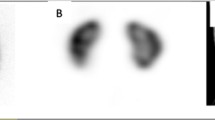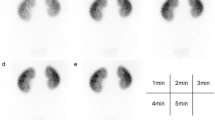Abstract
Technetium-99m dimercaptosuccinic acid (Tc-99m DMSA) as a static renal agent is currently the most frequently used agent in the detection of renal scarring, and allows accurate calculation of differential renal function (DRF). But this agent has some disadvantages such as relatively higher radiation dose and time consumption.Methods: The purpose of this study was to evaluate the potential of summed image that obtained from parenchymal phase of the dynamic technetium-99m-N,N-ethylenedicysteine (Tc-99m EC) scintigraphy in the detection of renal parenchymal defects and in the estimation of DRF, and to compare the results of this method with those of Tc-99m DMSA scintigraphy. The uptake ratios of the kidney to body background were also calculated for these two methods. Twenty-nine children with various renal disorders underwent both static Tc-99m DMSA and dynamic Tc-99m EC scintigraphy. The cortical analysis of Tc-99m EC scintigraphy was performed on the summed image obtained from dynamic images using the time interval between the first 45–120 sec.Results: There was a very close correlation between these two methods with respect to DRF (r=0.99). In the detection of renal parenchymal lesions, scintigraphy with Tc-99m DMSA detected more lesions, and the sensitivity and specificity of the summed Tc-99m EC images were calculated as 92.6% and 100%, respectively. In addition, the ratios of mean uptake values for Tc-99m DMSA and Tc-99m EC images were 7.59±2.17 and 2.95±0.91, respectively. This ratio of Tc-99m EC seems to be acceptable and allows good delineation of the kidneys. But, the main disadvantages of the summed Tc-99m EC images in comparison with static Tc-99m DMSA images are the use of only posterior projection that may be an important drawback in patients with abnormal kidney positions, lower image counts and higher pixel size because of dynamic acquisition.Conclusion: These results show that summed Tc-99m EC images with an acceptable high image contrast provide an accurate DRF calculation in patients without abnormal kidney positions and allow the detection of most renal parenchymal abnormalities. However, Tc-99m DMSA scintigraphy remains the gold standard method because of its well known advantages.
Similar content being viewed by others
References
Treves ST, Majd M, Kuruc A, Packard AB, Harmon W. Kidneys. In: Treves ST (ed),Pediatric Nuclear Medicine. New York; Springer Verlag, 1995; 339–399.
Convay JJ. The role of scintigraphy in urinary tract infection.Semin Nucl Med 1988; 18: 308–319.
Tamgaç F, moretti JL, Rocchisani JM, Baillet G, Weinmann P. Tc-99m MAG3 and Tc-99m DMSA in the detection and assessment of pyelonephritis.J Nucl Biol Med 1993; 37: 62–64.
Merrick MV, Uttley WS, Wild SR. The detection of pyelonephritic scarring in children by radioisotope imaging.Br J Radiol 1980; 53: 544–556.
Goldraich NP, Ramos OL, Goldraich IH. Urography versus DMSA scan in children with vesicoureteric reflux.Pediatric Nephrol 1989; 3: 1–5.
Willis KW, Martinez DA, Hedley WE, Uttley WS. Renal localization of Tc-99m stannous glucoheptonate and Tc-99m dimercaptosuccinate in the rat by frozen section autoradiography: the efficiency and resolution of technetium-99m.Radiat Res 1977; 69: 475–488.
Erlander D, Weber PM, dosRemedios LV. Renal cortical imaging in 35 patients: superior quality with Tc-99m DMSA.J Nucl Med 1974; 15: 743–749.
Arnold RW, Subramanian G, McAfee JG. Comparison of Tc-99m complexes for renal imaging.J Nucl Med 1975; 16: 357–367.
Smith T, Veall N, Altman G. Dosimetry of renal radiopharmaceuticals: the importance of bladder radioactivity and a simple aid for its estimation.Br J Radiol 1981; 54: 961–964.
Johansson L, Mattsson S, Nosslin B. Effective dose equivalent from radiopharmaceuticals.Eur J Nucl Med 1984; 9: 485–489.
Verboven M, Ham HR, Josephson S. How inaccurate are the 5 h measurements?Nucl Med Commun 1987; 8: 45–47.
Van Nerom C, Waer M, Claeys C, De Roo MJ. Clinical evaluation of Tc-99m-L,L-EC as an alternative for Tc-99m-MAG3 in renal transplant patients. In: Schmidt HAE, Hofer R (eds),Nuclear medicine in research and practice. Stuttgart, Germany; Schattauer, 1992: 560–563.
Verbruggen AM, Nosco LD, Van Nerom C, Bormans GM, Adriaens P, De Roo MJ. Technetium-99m-L,L-ethylenedicysteine: a renal imaging agent. I. Labeling and evaluation in animals.J Nucl Med 1992; 33: 551–557.
Van Nerom C, Bormans GM, De Roo M, Verbruggen AM. First experience in healthy volunteers with technetium-99m-L,L-ethylenedicysteine, a new renal imaging agent.Eur J Nucl Med 1993; 20 (9): 738–746.
Ozker K, Kabasakal L, Liu Y, Hellman RS, Isitman A, Krasnow AZ, et al. Evaluation of Tc-99m-bicisate as a renal imaging agent.Nucl Med Commun 1997; 18: 771–775.
Kabasakal L, Turoglu HT, Onsel Ç, et al. Comparative continuous infusion renal clearance of Tc-99m-EC, Tc-99m-MAG3 and I-131-OIH in renal disorders.J Nucl Med 1995; 36: 224–228.
Ugur O, Caner B, Cekirge S, Balkanci F, Ergun EL, Kostakoglu L, et al. The diagnosis of renovascular hypertension with technetium-99m-ethylenedicysteine captopril scintigraphy.Invest Radiol 1996; 31: 378–381.
Kibar M, Noyan A, Anarat A. Tc-99m-N,N-ethylenedicysteine scintigraphy in children with various renal disorder: a comparative study with Tc-99m-MAG3.Nucl Med Commun 1997; 18: 44–52.
Kabasakal L, Erdil TY, Ayaz M, et al. Evaluation of Tc-99m-EC in anuric hemodialysis patients.Eur J Nucl Med 1996; 23: 1187.
Kabasakal L. Technetium-99m ethylenedicysteine: a new renal tubular function agent.Eur J Nucl Med 2000; 27: 351–357.
Kabasakal L, Atay S, Vural VA, et al. Evaluation of technetium-99m-ethylenedicysteine in renal disorders and determination of extraction ratio.J Nucl Med 1995; 36: 1398–1403.
Eshima D, Eshima L, Hansen L, Lipowska M, Marzilli LG, Taylor A. Effect of protein binding on renal extraction of I-131 OIH and Tc-99m-labelled tubular agents.J Nucl Med 2000; 41: 2077–2082.
Stoffel M, Jamar F, Van Nerom C, Verbruggen A, Besse T, Squifflet JP, et al. Technetium-99m-L,L-ethylenedicysteine clearance and correlation with iodine-125 orthoiodohippurate for the determination of effective renal plasma flow.Eur J Nucl Med 1996; 23: 365–370.
Kabasakal L, Yapar AF, Ozker K, Alkan E, Atay S, Ozcelik N, et al. Simplified technetium-99m-EC clearance in adults from a single plasma sample.J Nucl Med 1997; 38: 1784–1786.
Kabasakal L, Halac M, Yapar AF, Alkan E, Kanmaz B, Onsel C, et al. Prospective validation of single plasma sample Tc-99m ethylenedicysteine clearance in adults.J Nucl Med 1999; 40: 429–431.
Itturalde MP.Dictionary and Handbook of Nuclear Medicine and Clinical Imaging. Boston: CRC Press, 1990: 433.
Ozker K, Onsel C, Kabasakal L, Sayman HB, Uslu I, Bozluolcay S, et al. Technetium-99m-N,N-ethylenedicysteine—A comparative study of renal scintigraphy with technetium-99m-MAG3 and Iodine-131-OIH in patients with obstructive renal disease.J Nucl Med 1994; 35: 840–845.
Gordon I, Colarinha P, Fettich J, Fischer S, Frökier J, Hahn K, et al. Guidelines for standard and diuretic renogram in children. http://www.eanm.org/scientific_info/guide_pdf/gl_reno_en.pdf
Piepsz A. Radionuclide studies in paediatric nephro-urology.Eur J Radiol 2002; 43 (2): 146–153.
Gupta NK, Bomanji JB, Waddington W, Lui D, Costa DC, Verbruggen AM, et al. Technetium-99m-L,L-ethylenedicysteine scintigraphy in patients with renal disorders.Eur J Nucl Med 1995; 22: 617–624.
Whitear P, Shaw P, Gordon I. Comparison of Tc-99m DMSA scans and in intravenous urography in children.Br J Radiol 1990; 63: 438.
Gordon I, Anderson PJ, Lythgoe MF, Orton M. Can technetium-99m-mercaptoacetyltriglycine replace technetium-99m-dimercaptosuccinic acid in the exclusion of a focal renal defect?J Nucl Med 1992; 33: 2090–2093.
Bair HJ, Becker W, Schott G, Kuhn RH, Wolf G. Is there still a need for Tc-99m DMSA renal imaging?Clin Nucl Med 1995; 20: 18–21.
Caglar M, Yaris N, Akyuz C. The utility of Tc-99m DMSA and Tc-99m EC scintigraphy for early diagnosis of ifosfamide induced nephrotoxicity.Nucl Med Commun 2001; 22 (12): 1325–1332.
Author information
Authors and Affiliations
Corresponding author
Rights and permissions
About this article
Cite this article
Kibar, M., Yapar, Z., Noyan, A. et al. Technetium-99m-N,N-ethylenedicysteine and Tc-99m DMSA scintigraphy in the evaluation of renal parenchymal abnormalities in children. Ann Nucl Med 17, 219–225 (2003). https://doi.org/10.1007/BF02990025
Received:
Accepted:
Issue Date:
DOI: https://doi.org/10.1007/BF02990025




